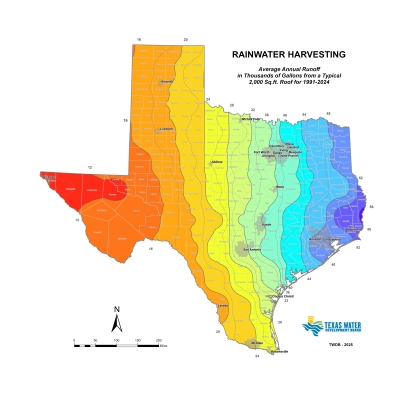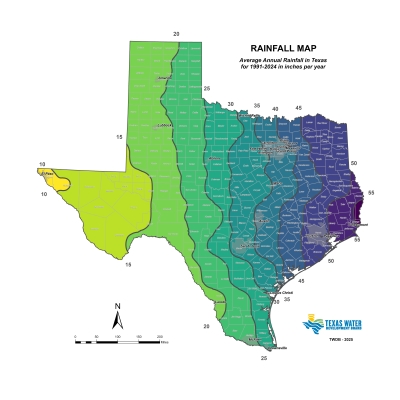Rainwater Volumes from Roof Runoff
Rainwater harvesting is useful if enough rainwater can be captured and stored to satisfy needs during dry periods. So, how much rainwater can a homeowner expect to collect and store in Texas? Assuming a collection efficiency of about 80 percent, it turns out that this volume is roughly 1,000 gallons for every inch of rainfall that falls on a 2,000 square-foot roof.
In Texas, average annual rainfall ranges from about 10 inches in the western parts of the state to over 60 inches in the eastern areas. Thus, a homeowner in West Texas with a 2,000 square-foot roof can expect to collect about 10,000 gallons annually while his counterpart in East Texas with the same roof area can expect to collect over 55,000 gallons. Of course, this volume can be prorated for roof areas of a different size. For example, a homeowner with a 1,000 square-foot roof in El Paso (average annual rainfall, 10 inches) can expect to collect about half of the volume that can be collected from a 2,000 square-foot roof (about 10,000 gallons). In other words, the homeowner can expect to collect about 5,000 gallons annually.
To facilitate a quick and easy way to estimate the amount of rainwater that can be collected from a roof in any location in Texas, we have developed a map (shown below) that shows average annual runoff from a 2,000 square-foot roof. The numbered lines on the map are isolines, connecting points of equal average annual runoff (in thousands of gallons).
Roof Runoff Map
Average Annual Runoff, 1991 to 2024
Download a pdf copy of the Roof Runoff Map (199 KB)
To use this map, simply identify your location on the map, read the numbers of the two lines that are on either side of the location, and multiply each number by 1,000. The amount of rainwater that you can expect to collect will range between the two numbers. For example, a homeowner in the Abilene area (west-central part of the state) with a 2,000 square-foot roof can expect to be able to collect between 24,000 and 28,000 gallons of rainwater annually.
Rainfall Map
Average Annual Rainfall, 1991 to 2024
More information about rainfall distribution, water balance, system sizing, and other aspects of rainwater harvesting are available in The Texas Manual on Rainwater Harvesting, Third Edition (2005) and in the Rainwater Harvesting Evaluation Committee Final Report (2006).